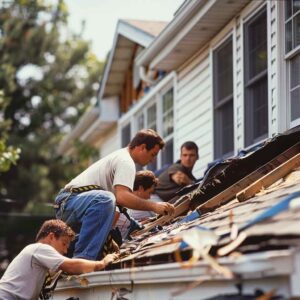Clearing moss from a roof requires a comprehensive approach, best executed with insights from a roofing expert. Understanding the significance of moss removal in preventing damage and preserving your home’s aesthetic appeal is paramount. Begin by gathering the necessary tools: a sturdy ladder, garden hose, scrub brush, moss killer, and safety gear. Assess the extent of moss growth, then gently scrub affected areas with a mix of soapy water using a brush. For stubborn spots, consider the use of zinc or copper strips. Additionally, address contributing factors such as overhanging branches and poor drainage, and employ preventative strips to inhibit regrowth. By mastering the process of roof moss removal, you contribute to maintaining your roof in prime condition for years to come.
Importance of Cleaning Moss Off Roof
Removing moss from the roof is vital to prevent long-term damage and maintain the structural integrity of your home. Moss removal benefits extend beyond just aesthetics. When moss accumulates on the roof, it can trap moisture, leading to premature deterioration of the roofing materials. This can result in leaks, rot, and even potential structural issues. Incorporating moss removal into your roof maintenance strategies is essential for prolonging the lifespan of your roof and avoiding costly repairs down the line.
Regularly cleaning moss off the roof enhances your home’s curb appeal and guarantees that your roof remains in top condition. This protects your investment and provides a safe environment for you and your family.
Materials Needed for Roof Moss Removal
Specific materials are essential for effectively cleaning moss off your roof, ensuring thorough removal and preventing damage to the roofing structure. When tackling roof moss removal, it’s important to have the right tools at hand. Some essential materials include a sturdy ladder to access the roof safely, a garden hose for initial rinsing, a stiff-bristled brush or a pressure washer for scrubbing off the moss, and a moss-killer solution to treat any remaining spores.
In addition, you may need safety gear such as gloves and goggles to protect yourself during the cleaning process. Having these materials ready, you can efficiently carry out the cleaning techniques required to maintain a moss-free roof.
Step-by-Step Guide to Clean Moss
When cleaning moss off your roof, safety is crucial. The first step involves evaluating the extent of the moss growth and identifying the areas that require attention. Moss removal techniques vary depending on the severity of the infestation. Using a long-handled scrub brush to remove the moss physically is adequate for light moss growth. Alternatively, water and mild detergent can be sprayed on the affected areas to loosen the moss before gently scrubbing it away.
Roof maintenance methods like zinc or copper strips can be installed for more stubborn moss to prevent future growth. When cleaning moss off your roof, following safety precautions, such as using a sturdy ladder and wearing appropriate footwear is important.
Tips to Prevent Moss Growth on Roof
Addressing the fundamental factors contributing to its development is essential to prevent moss growth on your roof. Proper moss prevention techniques and regular roof maintenance can significantly reduce the environmental impact of moss growth. Here are some tips to help you keep moss at bay:

- Trim Overhanging Branches: By cutting back branches that hang over your roof, you can minimize the shade and moisture that promote moss growth.
- Ensure Proper Drainage: Keeping gutters clean and properly drainage can prevent water from accumulating on your roof.
- Install Zinc or Copper Strips: When installed near the roof ridge, these metals can help inhibit moss growth.
- Regularly Inspect Your Roof: By inspecting your roof frequently, you can catch early signs of moss growth and take preventive action promptly.
Other Roofing Tips:




